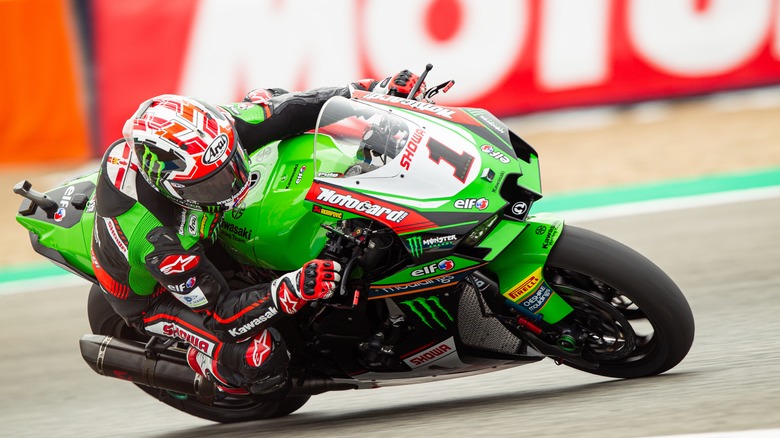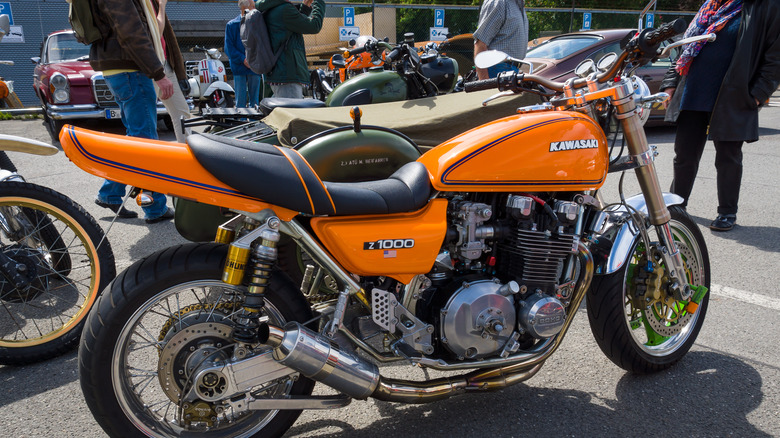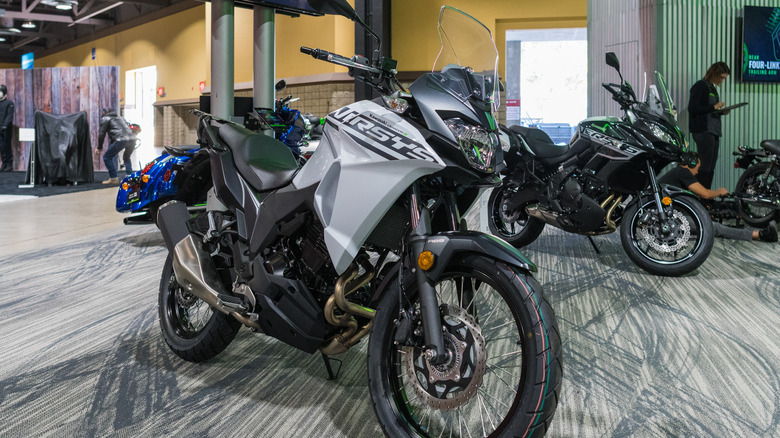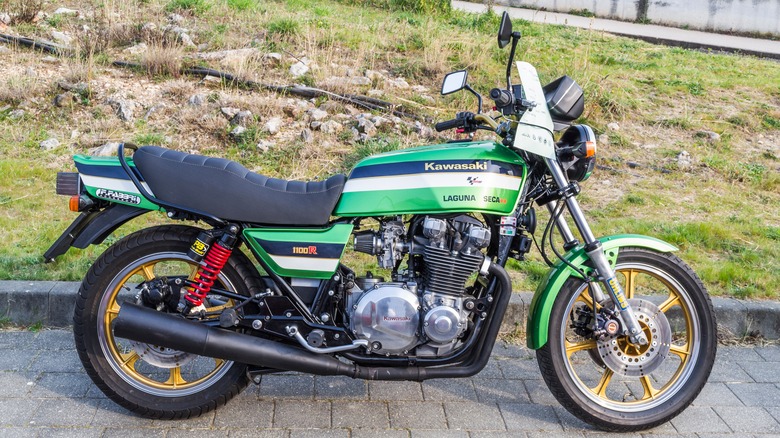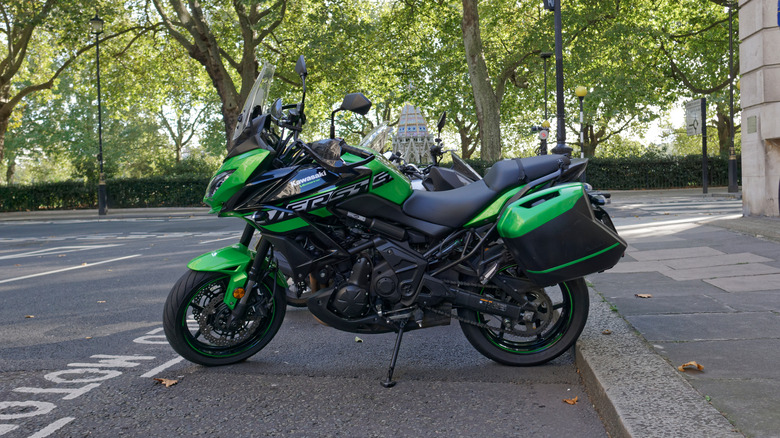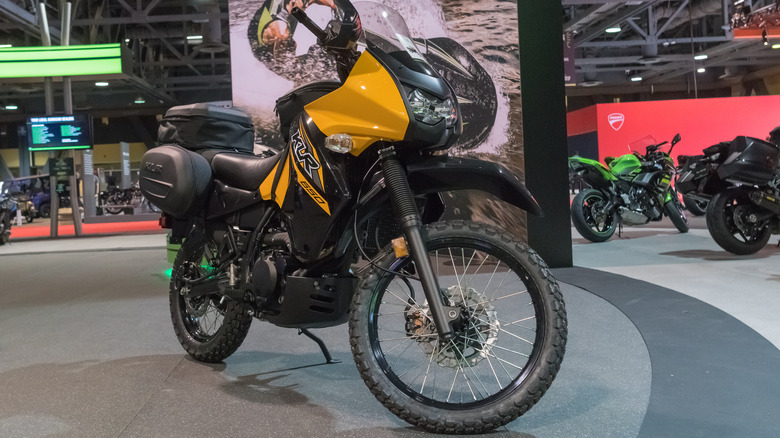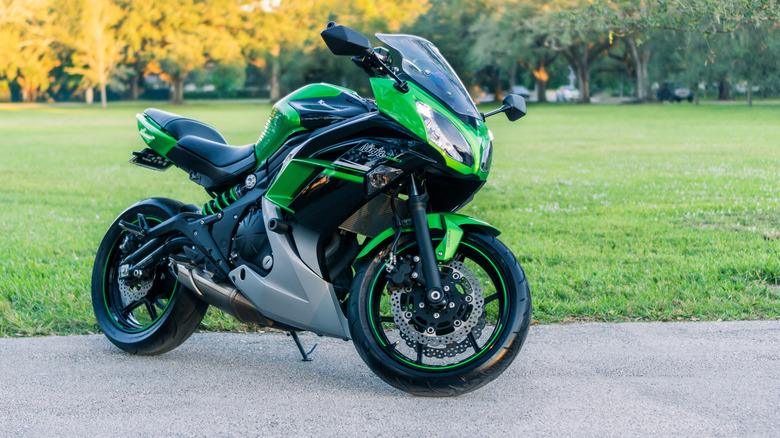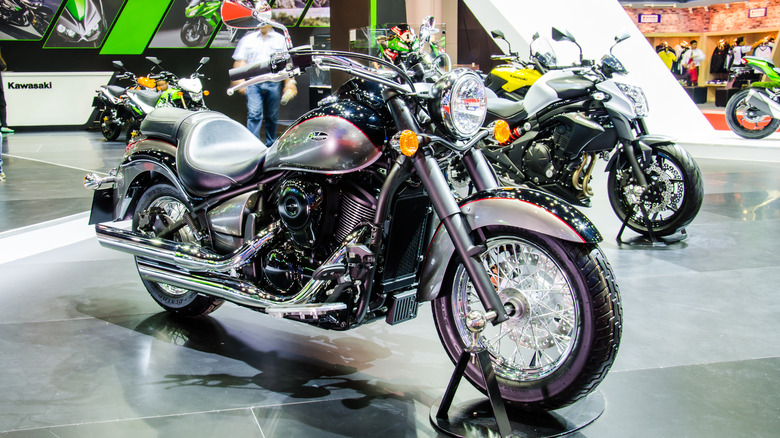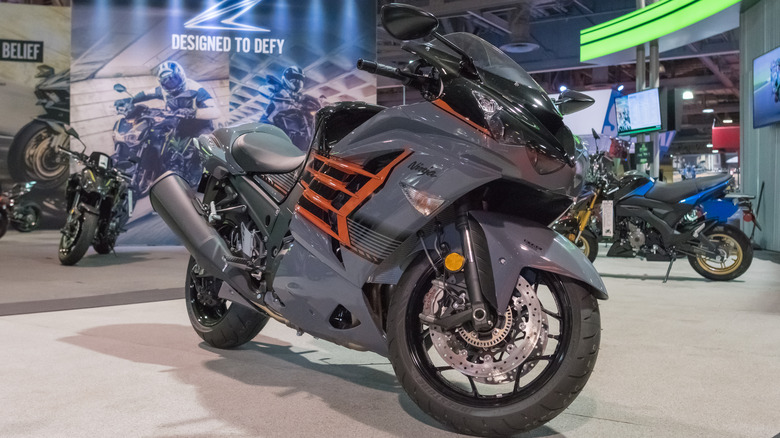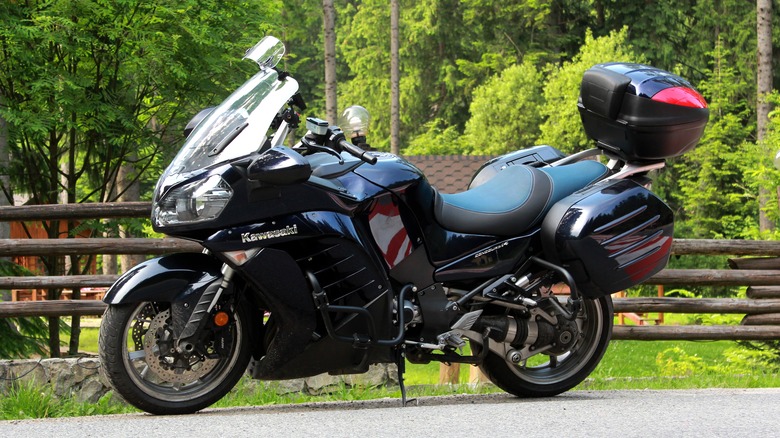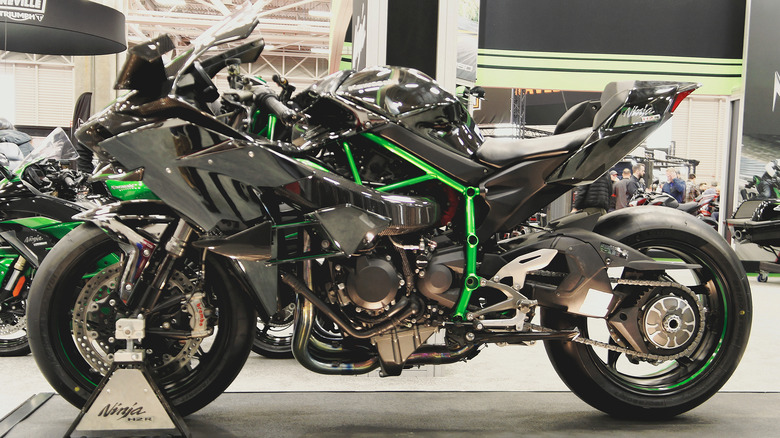The 10 Best Kawasaki Motorcycles Ever Made
The Japanese have a long and successful history in motorcycle manufacture, particularly the four distinguished brands: Honda, Suzuki, Yamaha, and Kawasaki. While Honda and Suzuki are also famous for their automobiles and Yamaha produces (somewhat bizarrely) musical instruments, Kawasaki has a history of shipbuilding and aircraft, missile, heavy machinery, and electronic goods production but is perhaps best known for its line of high-quality motorcycles.
Shōzō Kawasaki established Kawasaki Heavy Industries at the end of the 19th century, but it wasn't until 1962 that the Kawasaki Motorcycle Company created its first production motorcycle. Since then, the brand has gone from strength to strength, dominating the high-performance sport bike segment with its world-renowned "Ninja" line of performance bikes while also finding success with its dual-sport, cruiser, and touring vehicles.
Known for their engines' reliability and efficiency, as well as their often-green color schemes, Kawasaki has repeatedly broken production motorcycle speed records, most recently with its Ninja H2R model. They also perform exceptionally well when racing, having been highly competitive since the 1960s in such events as the Moto GP, Superbike World Championship, and Motocross World Championship.
The Kawasaki brand is well-established and constantly pushes the boundaries of a motorcycle's capabilities, ensuring a place in sporting history while continuing to satisfy millions of loyal customers worldwide with its diverse collection. Here we look at the ten most incredible machines to roll off this illustrious marque's production line in over 60 years of operation.
Kawasaki Z1000
There was a time in motorcycling history when sport bikes' braking, suspension, and tires hadn't entirely caught up to their power potential, and the Kawasaki Z1000 is a prime example of this. Massively overpowered for its handling performance, it rivaled Honda's CB 750 for the crown of the quickest street bike of the 1970s.
As an upgraded version of the even more primitive Kawasaki Z1, the Z1000 featured a revised frame that improved its handling compared to its earlier iteration. It was also a good looker, with a comfortable saddle and upright seating position, making it well-suited to touring longer distances. It was also reliable while being as fun as it was scary to ride.
When it came to its specifications, the Kawasaki z1000 was impressive in its day. Its 1015-cc, air-cooled, four-cylinder engine produced 83 horsepower at 8,000 rpm, reaching a top speed of 125 miles per hour. Typically, it features telescopic forks and a rear swing arm, but its single front disc left much to be desired in the braking department for a bike of this engine capacity. Despite its shortcomings, the original Kawasaki Z1000 was successful enough to inspire many subsequent models over the years and is still in production to the present day, also with the inline-four engine, albeit with contemporary styling and modern specs, such as dual anti-lock brakes, and a high-end suspension, which makes handling issues a thing of the past.
Kawasaki Versys 300X
Kawasaki came up with the Versys range to fill a gap in the market that nobody really knew existed at the time. That is to say, a sports tourer that has off-road capabilities, hence the name, which is a portmanteau of "versatile" and "system." The Kawasaki Versys 300X is among the smaller bikes in the Versys lineup (they recently produced a 250-cc model), which is ideal for beginners and is both affordable and fun to ride. Any novice rider looking to improve their roadgoing skills and make their first tentative steps into dual-sport territory might find this to be the ideal solution, as it handles well in both situations. However, it is also ideal for ducking through commuter traffic or as a light tourer for experienced riders looking for something nimbler than a fully-fledged adventure bike.
Indeed, the Kawasaki Versys 300X shares many features with its larger ADV cousins, such as a tall windshield, long travel suspension, and wire-spoked wheels, as well as a high exhaust, upright seating position, and a 32-inch seat height. ABS is optional, and a welcome inclusion for a bike of this size, and its 296-cc twin-cylinder engine produces a conservative 40 horsepower, which, while it may feel underpowered on the highway, is just fine for country roads and trails.
While the Kawasaki Versys 300X isn't a high-performance machine and will not set any records in any capacity, it is readily available to take you off the beaten track as quickly as you can don a helmet. It is a good-looking, adequately powered, and roadworthy bike for newer riders that won't break the bank, and it is similar to the excellent Honda CRF 300 Rally in terms of weight and handling.
Kawasaki GPZ1100
Like the stripped-down café racers of the 1960s, the 1980s saw many superbikes stripped of their fairings, creating a trend for "naked" superbikes that have continued to be popular up to the present day. The Kawasaki GPZ1100 was a four-cylinder monster, which was one of the earliest naked bikes and a precursor to the streamlined track bikes of the 1980s onwards. In appearance, it featured many attributes shared by modern superbikes, including a raked front cowl, double disc brakes up front, and upwardly-swept twin exhausts.
Unsheathed for all to see was the GPZ1100's bare engine, which was bulky in size and among the last of Kawasaki's air-cooled superbike blocks. It had a capacity of 1089-cc, digital fuel injection, and delivered a maximum of 120 horsepower, which is considerable even by today's standards.
Motorcycles have come a long way since the 1980s, especially in terms of handling. To this end, most modern superbikes use forks and brakes made by third parties, such as Ohlins, Showa Brembo, and Nissin, that offer superior shock absorbency and greater stopping power. To ride this bike from 1984 close to its top speed of 135 miles per hour took a lot of skill and courage or a complete disregard for one's own mortality, and for this, Kawasaki GPZ1100 owners of yesteryear, we salute you.
Kawasaki Versys 650
Much like its little brother, the Versys 300X, the Kawasaki Versys 650 is neither fish nor fowl, although this higher-powered model leans more towards the sports-touring segment than its off-road-friendly counterpart. Yet despite its identity crisis, this midsize tourer has proved extremely popular within the biking community and has been a regular fixture in the Kawasaki catalog since 2007.
In profile, the latest Versys 650 has typical adventure-tourer features, including a high (height-adjustable) windshield, an upright riding position, a high saddle of 33 inches, and a spacious pillion seat. Only its slightly lower ground clearance of 6.7 inches, its lack of wire spokes, and its relatively small 17-inch front wheel make it less suitable for off-roading and better suited to paved surfaces, but add a couple of panniers and a top box (included with the LT variant), and you have a roadgoing tourer that will take you anywhere. Its 649-cc liquid-cooled engine delivers over 60 Nm of torque, and it's fit for highway travel, with a top speed of just under 125 miles per hour, reaching 60 mph in 4.2 seconds. Like most modern mid-sized Japanese bike engines, it is known for being economical and reliable.
The Kawasaki Versys 650 has an impressive array of onboard features, including a TFT display with Bluetooth smartphone connectivity, ABS as standard, two modes of traction control, and fully adjustable front and rear suspensions. It also has a larger variant, the Versys 1000, but for affordability, versatility, maneuverability, and practicality, the 650 model gets our vote.
Kawasaki KLR650
No list of the best Kawasaki motorcycles would be complete without including their flagship dual-sport bike, the KLR650. Introduced in 1987, it is ideal for long-haul outbound trips, tackling rugged terrain, and highway riding. Such is its reliability, efficiency, and all-around performance that it has been used in off-road competitions, including the notorious Paris-Dakar Rally, and is the chosen motorcycle of the U.S. Marine Corps.
The Kawasaki KLR650 has barely changed since its conception, proof that it was a highly-successful off-roader from the outset, with the latest models adding electronic fuel injection and optional anti-lock brakes to the machine while keeping the specs very much the same. These include a liquid-cooled, four-stroke 652-cc engine, putting out 51.5 Nm of torque at 4,500 rpm. With a top speed of around 90 miles per hour, the KLR650 is no rocket, but with so much power at lower revs, it is highly competent when you turn off the beaten track. This capability is helped by its large 21-inch front wheel with almost 8 inches of travel and rear wheel travel of 7.3 inches. It has 8.3 inches of ground clearance below its skid plate, and even those of a taller stature will have trouble flat-footing it with its 34.3-inch seat height.
With the Kawasaki KLR650, the brand has adopted an "if it ain't broke, don't fix it" approach, mainly while leaving the basic specifications intact. For this, Kawasaki should be applauded, as it has remained one of the best dual sport bikes on the market for almost forty years.
Kawasaki Ninja 650
Taking the first steps into riding sports bikes can be a rather scary proposition even for experienced riders due to their acceleration, aggressive riding position, and different handling to other types of motorcycles. The Kawasaki Ninja 650 offers adequate power, excellent handling, and affordability, all in one aesthetically pleasing package. It has a rich heritage within its class, making it the ideal introduction for budding sports bike enthusiasts.
Introduced in 2006, the Kawasaki Ninja 650 (Then called the 650R) has been a mainstay of the Kawasaki catalog, and for good reason. Its engine's reliability and build quality are so good that it is used in other models (albeit re-tuned), including the Versys 650. The Ninja 650 produces over 67 horsepower and around 66 Nm of torque at 6,500 rpm. It has a six-speed gearbox and achieves 131 miles per hour when pushed, traveling from 0-60 miles per hour in under four seconds.
While these performance figures may not seem impressive as compared to higher-powered machines, it is the rider experience that the Kawasaki Ninja 650 is known for. It is truly a sum of its parts, with responsive handling, rider support features, a lightweight chassis, and slick styling, which all combine to make a day out on the Ninja 650 a thrilling and rewarding experience to equal that of larger capacity, quicker motorcycles.
Kawasaki Vulcan 900
Kawasaki isn't only known for its high-performance sports bikes, adventure tourers, and dual sport vehicles. It also has a long history of making cruisers, with the Vulcan range of mostly V-Twin bikes being the most prominent since 1984. The Kawasaki Vulcan 900 is the flagship of the brand's cruiser lineup and is the polar opposite of its performance bikes, with its low-slung saddle, forward foot pegs, and high handlebars.
Similar in appearance to the Harley-Davidson Softail, this belt-driven V-Twin beast had a particularly large 903-cc engine capacity for its class when first produced. As you'd expect from a bike of this category, it isn't quick, with a top speed of 115 miles per hour, and only requires single front and rear disc brakes for stopping. The Vulcan 900 is heavy at over 280 kilograms, but it is low, with a seat height of under 27 inches which offsets the weight, making it easy to maneuver, even at low speeds.
At a glance, you can tell the Kawasaki Vulcan 900 is built for comfort. Its plush, wide leather seat looks like you could sink into it, and its wide foot plates would make long highway rides easy on the feet as you relax and forget all about the brake and shifter for the next 100 miles. While it doesn't quite have the same heritage as the Harley-Davidson Softail Deluxe, it is around $5,000 less expensive and almost certainly more reliable, making the Vulcan 900 a much-loved alternative to its American counterpart.
Kawasaki Ninja ZX-14r
Kawasaki cemented their position as a producer of the fastest motorcycles with the Kawasaki Ninja ZX-14r. This is one of the quickest street-legal bikes in the world and is highly praised, both on and off the track, by the few who have the skills to ride one. Known as the "King of the Quarter Mile" due to its 9.73-second lap time, this monster machine is nothing short of impressive.
In profile, the ZX-14r looks like a Ninja on steroids, with its bulkier fairing, elongated 58.3-inch wheelbase, and powerful four-cylinder, 1,441-cc engine. Its speed and handling are assisted by a specially-designed ultralight aluminum monocoque frame, smooth power delivery, and fully-adjustable front and rear suspensions, which help it reach a blistering top speed of 186 miles per hour. Rider assists come in the form of front and rear ABS and Kawasaki traction control.
Along with its legendary status, premium parts, and specialist manufacturing techniques, one of the great features of the Kawasaki Ninja ZX-14r is its attainability, with a starting price of $15,599. Compare this to its rival, the Suzuki Hayabusa (which equals the ZX-14r's 186-mph top speed) at $18,799 to start, and we have a clear winner as far as value for money is concerned.
The Kawasaki Ninja ZX-14r is certainly a one-trick pony. As far as ownership is concerned, it is far from practical, far from comfortable, and far from sensible, but this is why we love it. Motorcycling is not an especially practical, social, or harmless pursuit. We mostly do it simply for fun, and the ZX-14r delivers that in spades.
Kawasaki Concours 14
Every great motorcycle manufacturer has a grand tourer in its catalog. Harley-Davidson has the Road Glide; BMW has the K1600GTL; Triumph has the Trophy 1200, and Honda has the class-leading Gold Wing. Kawasaki's offering for this segment is the Concours 14, which has proved very popular due to its capability to easily clock up long highway miles in great comfort while offering comparatively good value for money.
True to Kawasaki's form, the Concours 14, also known as the 1400GTR, is much sportier than its aforementioned rivals and is marketed as a sports tourer. If you were to remove the panniers, large windshield, and wide fairings, it has more in common with the Kawasaki Ninja ZX-14r (which it is based on), and a glance at its specifications confirms that the Concours 14 is a high-performance machine. Its four-cylinder 1,352-cc engine delivers 155 brake horsepower and enables a top speed of 155 miles per hour. It has a monocoque aluminum frame, inverted front forks, swing arm rear suspension, and a direct (shaft) drive, all features commonly found on sports bikes. Yet it has a more comfortable upright riding position, a wide seat, and high handlebars, and it offers a commanding view of the road ahead, as any touring bike should.
When faced with stiff competition, Kawasaki thinks outside the box, and it has become known for its successful line of sports tourers, including the Versys range of bikes. The Kawasaki Concours 14 is not entirely unique, but it has something else to offer compared to its highway-cruising counterparts; a comfortable, practical tourer that allows you to open up the throttle and leave the competitors for dust.
Kawasaki Ninja H2R
Some bikes were created only for the racetrack, and the Kawasaki Ninja H2R is one such machine that eclipses even the incredible BMW HP4 Race in terms of performance and technology. This non-street-legal motorcycle travels from 0-60 miles per hour in 2.93 seconds and boasts a top speed of 250 miles per hour, making it the fastest motorcycle in production by quite a margin. This fact alone should be enough to elevate this bike to the top of our list, but its specs also make for interesting reading.
Like a thoroughbred racehorse, the Ninja H2R is pure muscle, tuned to wring every ounce of power out of its 998-cc, four-cylinder, supercharged engine. Its high-tensile steel trellis frame is sprayed green, jutting out of the machinery like an exposed ribcage. Its fairings are carbon fiber and sculpted to provide maximum aerodynamics while looking like something imagined in a superhero comic. It is loaded with electronics, including an Inertial Measurement Unit (IMU), which controls acceleration when exiting corners, Kawasaki Launch Control to provide maximum acceleration from a standstill, Kawasaki Cornering Management Function, to optimize a rider's racing line while controlling pitch and lean angles, as well as multiple traction control modes and engine braking management.
You will not find such pedestrian and functional items as headlamps or wing mirrors on the Kawasaki Ninja H2R, but you will find a large pair of carbon fiber spoilers mounted on the front fairing. This perfectly sums up this machine. It was designed within Kawasaki's aerospace division purely to satisfy their curiosity as to the limitations of a road-going vehicle, and they deserve great praise for this remarkable achievement in setting a new benchmark for motorcycle performance.
